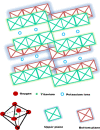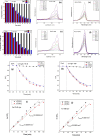Hydrothermal Synthesis of K2Ti6O13 Nanotubes/Nanoparticles: A Photodegradation Study on Methylene Blue and Rhodamine B Dyes
- PMID: 33778239
- PMCID: PMC7992068
- DOI: 10.1021/acsomega.0c02087
Hydrothermal Synthesis of K2Ti6O13 Nanotubes/Nanoparticles: A Photodegradation Study on Methylene Blue and Rhodamine B Dyes
Abstract
The degradation of methylene blue and rhodamine B dyes using potassium hexatitanate nanoparticles (KTNPs) and potassium hexatitanate nanotubes (KTNTs) synthesized via a hydrothermal method as efficient photocatalysts under UV light irradiation was investigated. The kinetics of degradation was determined for the two different catalysts--KTNPs and KTNTs--by monitoring the optical absorption of the dyes. The as-synthesized KTNPs were found to be spherical in shape with an average particle size of ∼36 ± 1.7 nm, whereas the KTNTs evidenced a tubular hollow structure with ∼7 nm internal diameter and ∼12 nm external diameter, as perused by structural and morphological studies. The larger surface area of KTNTs showed a greater impact on the photodegradation of dyes manifesting their high potential as compared to KTNPs under UV irradiation, and the reusability studies showed more than 90% (KTNTs) and 80% (KTNPs) degradation of the dyes even after the fourth cycle elucidating their stability.
© 2021 The Authors. Published by American Chemical Society.
Conflict of interest statement
The authors declare no competing financial interest.
Figures










Similar articles
-
Coupling ZnO with CuO for efficient organic pollutant removal.Environ Sci Pollut Res Int. 2023 Jun;30(28):71984-72008. doi: 10.1007/s11356-022-24139-6. Epub 2022 Nov 22. Environ Sci Pollut Res Int. 2023. PMID: 36414902
-
Hydrothermal synthesis and photocatalytic application of ZnS-Ag composites based on biomass-derived carbon aerogel for the visible light degradation of methylene blue.Environ Geochem Health. 2024 Feb 17;46(3):92. doi: 10.1007/s10653-024-01871-1. Environ Geochem Health. 2024. PMID: 38367085
-
A monodisperse anionic silver nanoparticles colloid: Its selective adsorption and excellent plasmon-induced photodegradation of Methylene Blue.J Colloid Interface Sci. 2018 Aug 1;523:98-109. doi: 10.1016/j.jcis.2018.03.011. Epub 2018 Mar 6. J Colloid Interface Sci. 2018. PMID: 29609128
-
Effectiveness of photocatalysis of MMT-supported TiO2 and TiO2 nanotubes for rhodamine B degradation.Chemosphere. 2021 Oct;280:130802. doi: 10.1016/j.chemosphere.2021.130802. Epub 2021 May 5. Chemosphere. 2021. PMID: 33975244
-
Designing Z-scheme AgIO4 nanorod embedded with Bi2S3 nanoflakes for expeditious visible light photodegradation of congo red and rhodamine B.Chemosphere. 2022 May;294:133755. doi: 10.1016/j.chemosphere.2022.133755. Epub 2022 Jan 25. Chemosphere. 2022. PMID: 35090849
Cited by
-
Bactericidal, anti-hemolytic, and anticancerous activities of phytofabricated silver nanoparticles of glycine max seeds.Front Chem. 2024 Aug 16;12:1427797. doi: 10.3389/fchem.2024.1427797. eCollection 2024. Front Chem. 2024. PMID: 39364440 Free PMC article.
-
Photocatalytic degradation of Rhodamine B dye over Ni-Cd doped and co-doped ZnO nanoparticles.Sci Rep. 2025 Aug 30;15(1):31947. doi: 10.1038/s41598-025-17684-w. Sci Rep. 2025. PMID: 40883394 Free PMC article.
References
-
- Kim Y.; McCoy L. T.; Lee E.; Lee H.; Saremi R.; Feit C.; Hardin I. R.; Sharma S.; Mani S.; Minko S. Environmentally Sound Textile Dyeing Technology with Nanofibrillated Cellulose. Green Chem. 2017, 19, 4031–4035. 10.1039/c7gc01662j. - DOI
LinkOut - more resources
Full Text Sources
Other Literature Sources

